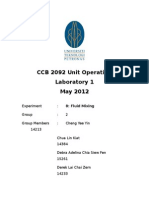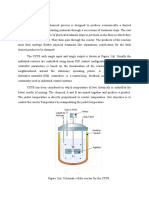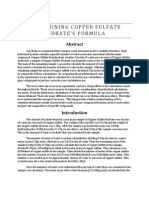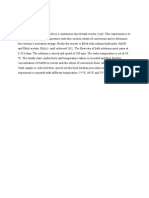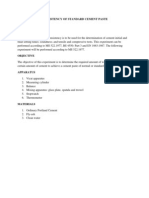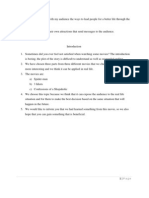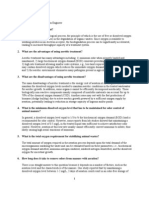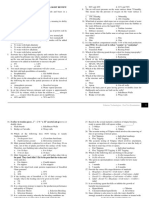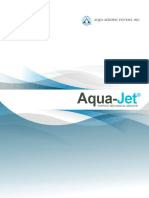EXPERIMENT 6 Aeration Test
EXPERIMENT 6 Aeration Test
Uploaded by
Muhammad Faiz Zafuan IdrusCopyright:
Available Formats
EXPERIMENT 6 Aeration Test
EXPERIMENT 6 Aeration Test
Uploaded by
Muhammad Faiz Zafuan IdrusCopyright
Available Formats
Share this document
Did you find this document useful?
Is this content inappropriate?
Copyright:
Available Formats
EXPERIMENT 6 Aeration Test
EXPERIMENT 6 Aeration Test
Uploaded by
Muhammad Faiz Zafuan IdrusCopyright:
Available Formats
CEEB221 INTRODUCTION TO ENVIRONMENTAL ENGINEERING LABORATORY EXPERIMENT 6.
0: AERATION TEST NAME ID SECTION : ZIA RAZIFF CHEE BIN FUDIN CHEE CE088743 02
DR. CHUA KOK HUA MISS SHIMA : 23 JULY, 2012
: :
LECTURER : LAB INSTRUCTOR:
DATE OF REPORT SUBMISSION
LAB REPORT MARKING Title Page Table of Content Objective Theory Anticipated Result Apparatus Procedure Results Discussions Conclusion Critique References Appendices Attendance TOTAL 1% 4% 5% 10% 10% 5% 5% 20% 15% 10% 5% 2% 3% 5% 100%
TABLE OF CONTENTS 1
No.
Item
Page 2 2 2 3 3- 4 5 5 6 6 6-7
6.1 Introduction 6.2 Objective 6.3 Apparatus 6.4 Procedure 6.5 Results (Data Observations) 6.6 Discussion 6.7 Summary 6.8 Conclusion 6.9 Refferences 6.10 Appendix
CEEB 221: INTRODUCTIONS TO ENVIRONMENTAL ENGINEERING LABORATORY EXPERIMENT 6.0: AERATION TEST
6.1 Introduction : Oxygen sufficiency is an important factor in water treatment processes, due to the fact that the livelihood of many of the aquatic species is depending on the oxygen present in water, also the microorganisms present in the water use the oxygen to digest the biodegradable substances in the water, in addition, the plants which grow inside the water also use the oxygen for photosynthesis, to grow and also produce more oxygen. There are two terms which are involved with the oxygen usage in the river, lake or etc. one is deoxygenation and other is reoxygenation, deoxygenation refers to usage of oxygen from plants and aquatic species, whereby reoxygenation is the process of introducing oxygen into the water, either by natural mean or human interfere. A simple definition of aeration could be the process whereby water is brought into intimate contact with air by spraying or cascading, or air is brought into intimate contact with water by an air aspirator or by bubbling compressed air through the body of water. Both pressure (closed) aerators and open (gravity) aerators are used. Closed aeration is used chiefly for oxidation; open aeration for degassing. Aeration is the process, by which oxygen is introduced into water for different purposes, from disinfection, to providing oxygen for the microorganism to digest the organic biodegradable substances in water, to remove the odor the water, and prevent it to become septic in the water treatment plants. 6.2 Objective The objective of the experiment is to determine the transfer efficiency of an aerator. Also, the objective of the experiment is to determine the rate of deoxygenation and reoxygenation of a water sample using sodium sulphate and a catalyst of Cobaltous Chloride. 6.3 Apparatus Apparatus 1. Circular tank 2. Aerator 3. DO probe 4. Spatula Chemicals and materials 1. Cobaltous Chloride 2. Sodium Sulphate 3. Distilled water 4. Water sample
6.4 Procedure 3
1. A circular, black tank was used as the container 2. A sample of fresh water was poured inside the tank, the height and diameter of the water was taken, inside the tank. The DOo of the water sample was recorded. 3. Addition of Cobaltous Chloride, the catalyst, and Sodium Sulphate was started at this point, with gentle stirring of the mixture. 4. DO probe was washed and rinsed with distilled water and placed in the tank to take the amount of dissolved oxygen. 5. The readings were recorded as the dissolved oxygen was decreasing, 6. When the minimum amount of dissolved oxygen, 1.89, was reached, the DO probe was once again rinsed with distilled water and placed into the deoxygenated sample, 7. Readings of the amount of DO was taken every 1 minute interval until the original amount of DO was reached. 8. The required analysis was done on the data collected, graphs were plotted and calculations were done, as you can see further in next parts. 6.5 Results (Data Observations)
Time,min 0 3 6 8 10 12 14 16 20 25 30 35 40
DO,mg/l 0.02 0.29 1.21 1.61 2.17 2.47 2.75 3.27 3.64 3.91 4.27 4.44 4.52
-C 8.18 7.91 6.99 6.59 6.03 5.73 5.45 4.93 4.56 4.29 3.93 3.79 3.68
Calculation 4
Cs = 8.2 mg/l ; Temperature = 26C ; Diameter of container = 34cm ; Height = 36.5cm = ln(Cs- ) ln (Cs= ln (6) ln (4.2) 25-10 = 0.3567 15 = 0.0238/min )
Standard =
at 20C ( ) )
= 0.0238 ( = 0.0206/min Oxygenation capacity = 9.1 mg/l Area,A= = = 0.0908
Volume of water = Area Height = 0.0908 0.3650 = 0.0331 = 33.1 OC = Volume of water
= 0.0206 9.1 33.1 = 6.2049 mg/min 10,000 = 6.2049 kg/min
6.6 Discussion The errors we committed in this experiment was addition of catalyst and the other reagent without any scale or calculation, hence the results were not very accurate. In addition, while measuring the height and the diameter of the cylinder there might have been some parallax errors and hence not having a correct volume. Furthermore, it can be seen from the data that there had been some faulty reading, because when the readings are supposed to decrease, some of the readings are increasing and vice versa.It is known that, the best way of addition of chemicals, is by usage of the diffused system, where we can add the catalyst and Sodium Sulphate from bottom, however in our experiment we just added the chemical with spatula.Also the mixing and stirring of the water sample might not have been entirely uniform, resulting in some of the catalyst and reagent dropping down to the tank and not reacting with the water.Overall, it can be said that the experiment was done correctly, and we were able to get the data required and do the analysis. 6.7 Summary The test procedure involves measuring dissolved oxygen from near zero to saturation against time, and non linear regression is used to determine the mass transfer coefficient. To achieve near zero dissolved oxygen concentration, the water sample is deoxygenated using sodium sulphite. Power consumption of the aeration devices is monitored using power monitoring equipment suitable for systems equipped with variable speed drives. It is common to test aeration systems at several duty points to determine the efficiency across the whole operational range of a particular system. In this experiment, fist a small circular, plastic tank was chosen for this experiment, and fresh water was poured inside it, then Cobaltous Chloride, which is the catalyst, was added into the sample, followed by addition of Sodium, Sulphate, in order to deoxygenize the water. These two chemicals were added to the tank until a point which the DO meter read a value of 1.89, meaning that most of the oxygen in the water sample had escaped. When that point was reached, the aerator was put inside the tank and the bubbles producing bubbles inside the water, and hence reoxygenizing the mixture. At each minute the value that the DO probe read was recorded, also the height of the water and the diameter of the tank was recorded, for further calculation and analysis of the data that we had calculated in this experiment.
6.8 Conclusion 6
As for the conclusion it can be stated that this experiment met satisfaction and the objective of the experiment was met, we were able to deoxygenize the water and reoxygenize it, recognize the reagents and the catalysts, also we can now find the rate of deoxygenization and deoxygenization.
6.9 Refference Lecture note from Dr. Chua Kok Hua ; Introduction to Environment Engineering.
6.10 Appendix
You might also like
- Claviceps Purpurea and LSD SynthesisDocument5 pagesClaviceps Purpurea and LSD SynthesisPán Rostlin100% (1)
- Comparison of Jet Aeration Systems vs. Diffused Aeration SystemsDocument8 pagesComparison of Jet Aeration Systems vs. Diffused Aeration SystemsChristopher LloydNo ratings yet
- Gas AbsorptionDocument26 pagesGas AbsorptionElvin GarashliNo ratings yet
- CSTRDocument12 pagesCSTRsamueloNo ratings yet
- J. Chem. Thermodynamics: J. Soujanya, B. Satyavathi, T.E. Vittal PrasadDocument4 pagesJ. Chem. Thermodynamics: J. Soujanya, B. Satyavathi, T.E. Vittal PrasadAngie Paola AcostaNo ratings yet
- Lab Report 1 Diffusion Across Biological Membrances SimulationDocument7 pagesLab Report 1 Diffusion Across Biological Membrances SimulationAmeena Ali50% (2)
- Initial Concentration of NaOH in Feed VesselDocument2 pagesInitial Concentration of NaOH in Feed VesselZeenat RanaNo ratings yet
- The NRTLDocument4 pagesThe NRTLMustafa AbdallaNo ratings yet
- Lab ReportDocument9 pagesLab ReportArslan Mir100% (1)
- CRE Lab ManualDocument32 pagesCRE Lab ManualAABID SHAIK100% (1)
- Methodology For Pollution Control of Lakes and ManagementDocument19 pagesMethodology For Pollution Control of Lakes and ManagementESSENCE - International Journal for Environmental Rehabilitation and ConservaionNo ratings yet
- Industrial Training Report (Edit)Document30 pagesIndustrial Training Report (Edit)mirdza94No ratings yet
- Chgairflowlab JOSHI CAREYDocument20 pagesChgairflowlab JOSHI CAREYelsmuchoNo ratings yet
- Tray Dryer Objectives: Calculate The Percentage Moisture Content of Wet Rice Husk Removed in A Rotary Drier byDocument4 pagesTray Dryer Objectives: Calculate The Percentage Moisture Content of Wet Rice Husk Removed in A Rotary Drier byHajra AamirNo ratings yet
- Chemical Reaction: (Batch Reactor)Document15 pagesChemical Reaction: (Batch Reactor)Ahmed ZakariaNo ratings yet
- IYOHA COLLINS 16CF020531 Batch Reactor ReportDocument19 pagesIYOHA COLLINS 16CF020531 Batch Reactor ReportDavid OvieNo ratings yet
- 1180 Exp 04, Density and Specific GravityDocument13 pages1180 Exp 04, Density and Specific GravityShaniCoolestNo ratings yet
- Problems On Batch Reactor-2Document11 pagesProblems On Batch Reactor-2Subhajit BagNo ratings yet
- UO 4 Solid Handling UnitDocument17 pagesUO 4 Solid Handling UnitNoor FadzleenaNo ratings yet
- Chemical Kinetics: Chung (Peter) Chieh Professor of Chemistry University of Waterloo Waterloo, Ontario, CanadaDocument34 pagesChemical Kinetics: Chung (Peter) Chieh Professor of Chemistry University of Waterloo Waterloo, Ontario, Canadadescar84No ratings yet
- Experiment8 Fluid MixingDocument28 pagesExperiment8 Fluid MixingZen AlkaffNo ratings yet
- PFR ReactorDocument19 pagesPFR Reactorkhairi100% (2)
- Integral Method of Analysis of DataDocument15 pagesIntegral Method of Analysis of DataImran UnarNo ratings yet
- (Unit Operations Laboratory-2) : Name: Siraj Ali Aldeeb ID: 3214118Document11 pages(Unit Operations Laboratory-2) : Name: Siraj Ali Aldeeb ID: 3214118Siraj AL sharifNo ratings yet
- Lab Report Cstr-Intro Appa ProceDocument6 pagesLab Report Cstr-Intro Appa Procesolehah misniNo ratings yet
- Lab Report 1Document5 pagesLab Report 1Marlaina WilliamsNo ratings yet
- CELCHA2 Study GuidesDocument7 pagesCELCHA2 Study GuidesEsther100% (1)
- PFRDocument19 pagesPFRKangae IlhamNo ratings yet
- Report PFRDocument21 pagesReport PFRMuhamad Hafifi Ajwad100% (2)
- CSTR ManualDocument11 pagesCSTR ManualMelly FulaNo ratings yet
- Determination of Head Loss in Fixed & Fluidised BedDocument6 pagesDetermination of Head Loss in Fixed & Fluidised BedElaine PuiNo ratings yet
- PBR Ideal Case DesignDocument22 pagesPBR Ideal Case Designhinman714No ratings yet
- Elements of Mass Transfer (Part 1) - N. Anantharaman and K. M. M. S. BegumDocument115 pagesElements of Mass Transfer (Part 1) - N. Anantharaman and K. M. M. S. BegumMoyses Naves de MoraesNo ratings yet
- f2 Sedimentation Practical Report For s3 LevelDocument17 pagesf2 Sedimentation Practical Report For s3 Levelbaddierobie12No ratings yet
- Experiment No 1 (Tray Dryer)Document8 pagesExperiment No 1 (Tray Dryer)mjunaidNo ratings yet
- CSTR in SeriesDocument17 pagesCSTR in SeriesDhiyyah MardhiyyahNo ratings yet
- Thermal Analysis: Dr. Jyoti Prakash DhalDocument59 pagesThermal Analysis: Dr. Jyoti Prakash DhalBhagyashree PaniNo ratings yet
- CSTRDocument21 pagesCSTRirfan hilmanNo ratings yet
- Mass Transfer Without Chemical ReactionDocument3 pagesMass Transfer Without Chemical ReactionDhananjay Kadam0% (1)
- P4E2: Kinetics of Homogeneous Reaction in Batch and Continuous Stirred-Tank Reactor at Two Different TemperatureDocument7 pagesP4E2: Kinetics of Homogeneous Reaction in Batch and Continuous Stirred-Tank Reactor at Two Different TemperaturejayaprinaNo ratings yet
- CHE522 1st ClassDocument15 pagesCHE522 1st ClassAnas IqmalNo ratings yet
- Fractional DistillationDocument5 pagesFractional Distillationihack_101No ratings yet
- CSTR 40LDocument17 pagesCSTR 40LMuhammad Affifudin100% (1)
- Dropwise and Filmwise Condensation PDFDocument5 pagesDropwise and Filmwise Condensation PDFmustafa100% (2)
- Cre Exp 10 Lab Report (PFR)Document10 pagesCre Exp 10 Lab Report (PFR)sukhmani100% (1)
- CSTR 40 LDocument28 pagesCSTR 40 LCik Tiem Ngagiman50% (2)
- Conclusion Free VortexDocument1 pageConclusion Free VortexNadiaNo ratings yet
- Humidification and Air Conditioning: Lecture No. 8Document6 pagesHumidification and Air Conditioning: Lecture No. 8Anonymous UFa1z9XUANo ratings yet
- Mto Lab Manuals - All ExperimentsDocument121 pagesMto Lab Manuals - All ExperimentsAnmol JainNo ratings yet
- Laboratory Report F3: Coefficient of Difusivity: ObjectivesDocument7 pagesLaboratory Report F3: Coefficient of Difusivity: ObjectivesCristhianRondónNo ratings yet
- Membrane FilterDocument5 pagesMembrane FilterWan Ahmad IrfanNo ratings yet
- Experiment No: 6: Feed Tanks Batch ReactorDocument5 pagesExperiment No: 6: Feed Tanks Batch Reactorfareeha saeedNo ratings yet
- Motion of Particles in A FluidDocument15 pagesMotion of Particles in A FluidEndris AliNo ratings yet
- Sorrel ExtractionDocument20 pagesSorrel ExtractionKid ArachnidNo ratings yet
- Surface TensionDocument5 pagesSurface Tensiondoulat2000No ratings yet
- KineticsDocument123 pagesKineticssamueloNo ratings yet
- Lecture 2 MassMicroDocument25 pagesLecture 2 MassMicroPelin KınıkNo ratings yet
- CSTR 40LDocument13 pagesCSTR 40LAzmiMamatNo ratings yet
- Introductory Applications of Partial Differential Equations: With Emphasis on Wave Propagation and DiffusionFrom EverandIntroductory Applications of Partial Differential Equations: With Emphasis on Wave Propagation and DiffusionNo ratings yet
- Deactivation of Heavy Oil Hydroprocessing Catalysts: Fundamentals and ModelingFrom EverandDeactivation of Heavy Oil Hydroprocessing Catalysts: Fundamentals and ModelingNo ratings yet
- Chemical Reaction Kinetics: Concepts, Methods and Case StudiesFrom EverandChemical Reaction Kinetics: Concepts, Methods and Case StudiesNo ratings yet
- Scaling Analysis in Modeling Transport and Reaction Processes: A Systematic Approach to Model Building and the Art of ApproximationFrom EverandScaling Analysis in Modeling Transport and Reaction Processes: A Systematic Approach to Model Building and the Art of ApproximationNo ratings yet
- G4 Exp5Document9 pagesG4 Exp5Naresh GanisonNo ratings yet
- Item Rate (RM) Amount (RM) Number Description Unit QTY Budget Code DescriptionDocument2 pagesItem Rate (RM) Amount (RM) Number Description Unit QTY Budget Code DescriptionMuhammad Faiz Zafuan IdrusNo ratings yet
- Traffic Volume StudyDocument15 pagesTraffic Volume StudyMuhammad Faiz Zafuan Idrus100% (3)
- EXPERIMENT 2 Suspended SolidDocument7 pagesEXPERIMENT 2 Suspended SolidMuhammad Faiz Zafuan Idrus67% (3)
- Vane Shear TestDocument4 pagesVane Shear TestMuhammad Faiz Zafuan Idrus100% (1)
- Consistency of Standard Cement PasteDocument5 pagesConsistency of Standard Cement PasteMuhammad Faiz Zafuan Idrus67% (3)
- Outline SpeechDocument10 pagesOutline SpeechMuhammad Faiz Zafuan IdrusNo ratings yet
- RSD, RCD, RCT, RSD144 DIFFUSER Catalogue (New)Document8 pagesRSD, RCD, RCT, RSD144 DIFFUSER Catalogue (New)Ake'a JantharopasakornNo ratings yet
- HydroBloom by Blue Planet EnvironmentalDocument2 pagesHydroBloom by Blue Planet EnvironmentalhgordonsmithNo ratings yet
- Jet AerationDocument6 pagesJet AerationIzhary Siregar100% (1)
- Air Striping & AerationDocument31 pagesAir Striping & Aerationnasir mehranbod100% (1)
- Thesis Report GOKUL ANNADocument98 pagesThesis Report GOKUL ANNABramodh JayanthiNo ratings yet
- Treatment Processes, Pretreatment: Draft Guidelines For Drinking-Water Quality Management For New Zealand, October 2005Document19 pagesTreatment Processes, Pretreatment: Draft Guidelines For Drinking-Water Quality Management For New Zealand, October 2005Ross ZhouNo ratings yet
- Red Swamp CrayfishDocument21 pagesRed Swamp CrayfishmalamskiNo ratings yet
- (INFOMINA) Energy Use in Aquaculture Pond Aeration Part 1 - 2Document9 pages(INFOMINA) Energy Use in Aquaculture Pond Aeration Part 1 - 2irlyvara nandiniNo ratings yet
- Process Systems: Tri-Oval SystemDocument2 pagesProcess Systems: Tri-Oval SystemJ MIGUEL CERVANTES ANo ratings yet
- BZ Est PD 002 Control Philosophy TestDocument55 pagesBZ Est PD 002 Control Philosophy TestMertoiu GabrielNo ratings yet
- Aerobic Treatment FAQsDocument4 pagesAerobic Treatment FAQsvince6111No ratings yet
- Self Aspirating Turbine Aerator For All Kind of LiquidDocument16 pagesSelf Aspirating Turbine Aerator For All Kind of LiquidChandra Sekar R0% (1)
- Allproductsaerationbrochure2011 000 PDFDocument2 pagesAllproductsaerationbrochure2011 000 PDFnazar750No ratings yet
- Bioreactor Engineering Module-1 Basic Design and Construction of A Fermentor and Its AncillariesDocument23 pagesBioreactor Engineering Module-1 Basic Design and Construction of A Fermentor and Its AncillariesssfoodtechNo ratings yet
- Ninad Kelkar Rehau PolymersDocument42 pagesNinad Kelkar Rehau PolymersAbhinav SrivastavaNo ratings yet
- Aquaculture Post Test 2019Document3 pagesAquaculture Post Test 2019Eldhen Grencio OrgelaNo ratings yet
- Imran Project PresentationDocument71 pagesImran Project PresentationimranNo ratings yet
- Waste Water Treatment Waste Water Treatment: AerationDocument100 pagesWaste Water Treatment Waste Water Treatment: AerationAndré OliveiraNo ratings yet
- Eng-Diffuser Digital CatalogueDocument27 pagesEng-Diffuser Digital CatalogueMazwan Che MansorNo ratings yet
- Water Quality Management For Production of Freshwater Ornamental SHDocument14 pagesWater Quality Management For Production of Freshwater Ornamental SHVarun KNo ratings yet
- BioReco SlideDocument12 pagesBioReco SlideNiels WandlerNo ratings yet
- AquaJet 2015 Singlepages WebDocument6 pagesAquaJet 2015 Singlepages WebestyNo ratings yet
- Activated Sludge Design Calculations Date: Project: Units: Engineer: Act. Sludge Process: Design Conditions & ParametersDocument5 pagesActivated Sludge Design Calculations Date: Project: Units: Engineer: Act. Sludge Process: Design Conditions & ParametersMagin Idelfonso TorreblancaNo ratings yet
- K Pack Systems Pvt. LTD.: Www. Kpack - inDocument20 pagesK Pack Systems Pvt. LTD.: Www. Kpack - inBắp BắpNo ratings yet
- Oxidation DictchDocument12 pagesOxidation DictchKhang Trần100% (1)
- 2.6 Operation and Maintenance of Water FacilitiesDocument30 pages2.6 Operation and Maintenance of Water FacilitiesekoNo ratings yet




















